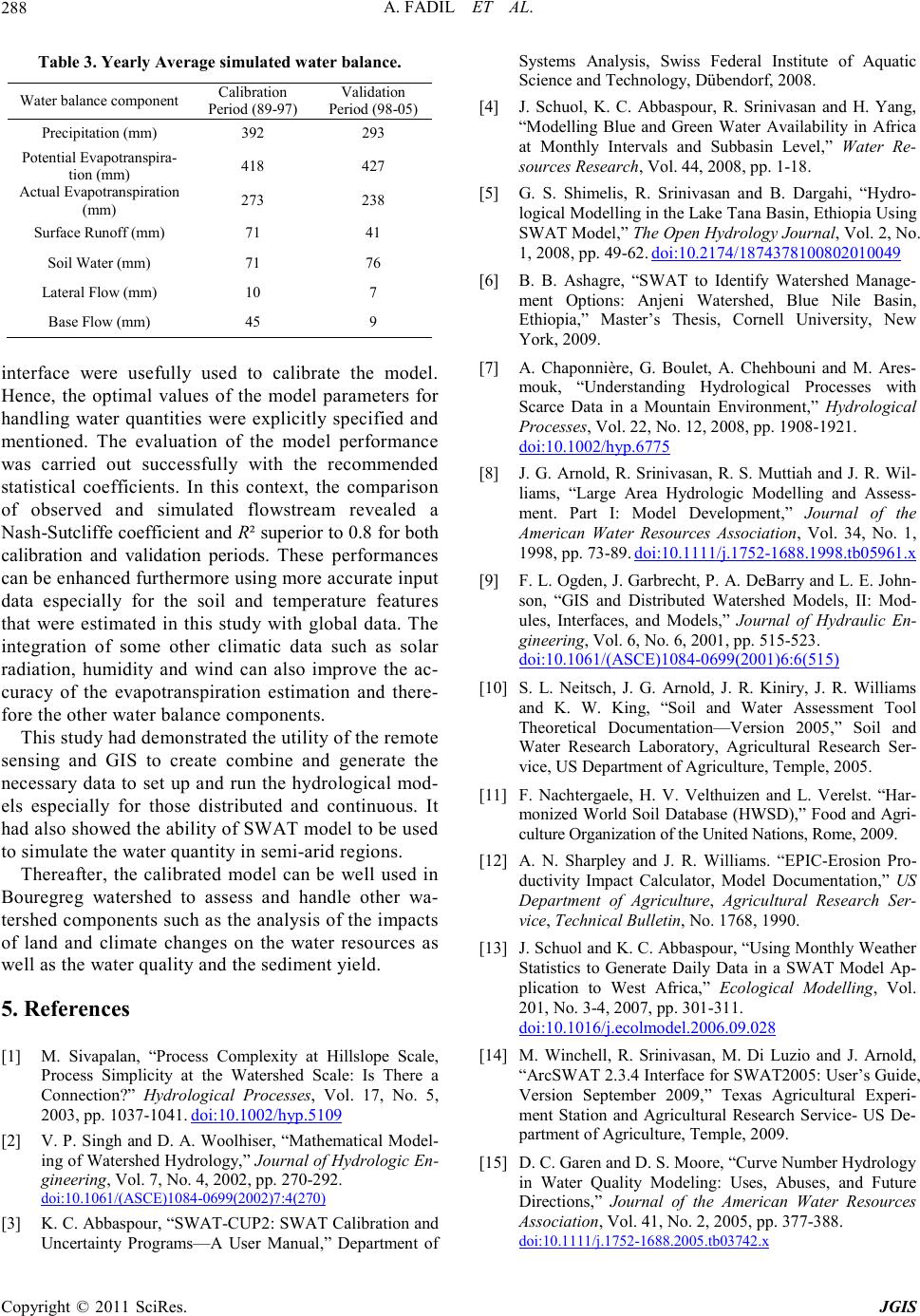
A. FADIL ET AL.
288
Table 3. Ye ar ly Average simula ted water balance.
Water balance component Calibration
Period (89-97) Validation
Period (98-05)
Precipitation (mm) 392 293
Potential E v apotr anspira-
tion (mm ) 418 427
Actual Evapotrans pirati on
(mm) 273 238
Surface Runoff (mm) 71 41
Soil Water (mm) 71 76
Lateral Flow (mm) 10 7
Base Flow (mm) 45 9
interface were usefully used to calibrate the model.
Hence, the optimal values of the model parameters for
handling water quantities were explicitly specified and
mentioned. The evaluation of the model performance
was carried out successfully with the recommended
statistical coefficients. In this context, the comparison
of observed and simulated flowstream revealed a
Nas h-Sutcliffe coefficient and R² superior to 0.8 for both
calibration and validation periods. These performances
can be enhanced furt hermore using more accura te input
data especially for the soil and temperature features
that were estimated in this study with global data. The
integration of some other climatic data such as solar
radiation, humidity and wind can also improve the ac-
curacy of the evapotranspiration estimation and there-
fore the other water bala nce co mponents.
This study had demonstrated the utility of the remote
sensing and GIS to create combine and generate the
necessary data to set up and run the hydrological mod-
els especially for those distributed and continuous. It
had also showed the ability of SWAT model to be used
to si mulate t he water quantit y in se mi-arid r e gio ns.
Thereafter, the calibrated model can be well used in
Bouregreg watershed to assess and handle other wa-
tershed components such as the analysis of the impacts
of land and climate changes on the water resources as
well as the water quality and the sediment yield.
5. References
[1] M. Sivapalan, “Process Complexity at Hillslope Scale,
Process Simplicity at the Watershed Scale: Is There a
Connection?” Hydrological Processes, Vol. 17, No. 5,
2003, pp. 1037-104 1. doi:10.1002/hyp.5109
[2] V. P. Singh and D. A. Woolhiser, “Mathematical Model-
ing of Watershed Hydrology,” Journal of Hydrologic En-
gineering, Vol. 7, No. 4, 2002, pp. 270-292.
doi:10.1061 /(ASCE)1084-069 9(2002)7:4(270)
[3] K. C. Abbaspour, “SWAT-CUP2: SWAT Calibration and
Uncertainty Programs—A User Manual,” Department of
Systems Analysis, Swiss Federal Institute of Aquatic
Science and Technology, Dübendorf, 2008.
[4] J. Schuol, K. C. Abbaspour, R. Srinivasan and H. Yang,
“Modelling Blue and Green Water Availability in Africa
at Monthly Intervals and Subbasin Level,” Water Re-
sources Research, Vol. 44, 2008, pp. 1-18.
[5] G. S. Shimelis, R. Srinivasan and B. Dargahi, “Hydro-
logical Modelling in the Lake Tana Basin, Ethiopia Using
SWAT Model,” The Open Hydrology Journal, Vol. 2, No.
1, 2008, pp. 49-62. doi:10.2174/1874378100802010049
[6] B. B. Ashagre, “SWAT to Identify Watershed Manage-
ment Options: Anjeni Watershed, Blue Nile Basin,
Ethiopia,” Master’s Thesis, Cornell University, New
York, 2009.
[7] A. Chaponnière, G. Boulet, A. Chehbouni and M. Ares-
mouk, “Understanding Hydrological Processes with
Scarce Data in a Mountain Environment,” Hydrological
Processes, Vol. 22, No. 12, 2008, pp. 1908-1921.
do i:10.1002/hyp.6775
[8] J. G. Arnold, R. Srinivasan, R. S. Muttiah and J. R. Wil-
liams, “Large Area Hydrologic Modelling and Assess-
ment. Part I: Model Development,” Journal of the
American Water Resources Association, Vol. 34, No. 1,
1998, pp. 73- 8 9. doi:10.1111/j.1752-1688.1998.tb05961.x
[9] F. L. Ogden, J. Garbrecht, P. A. DeBarry and L. E. John-
son, “GIS and Distributed Watershed Models, II: Mod-
ules, Interfaces, and Models,” Journal of Hydraulic En-
gineering, Vol. 6, No. 6, 2001, pp. 515-523.
doi:10.1061/(ASCE)1084-0699(2001)6:6(515)
[10] S. L. Neitsch, J. G. Arnold, J. R. Kiniry, J. R. Williams
and K. W. King, “Soil and Water Assessment Tool
Theoretical Documentation—Version 2005,” Soil and
Water Research Laboratory, Agricultural Research Ser-
vice, US Department of Agriculture, Temple, 2005.
[11] F. Nachtergaele, H. V. Velthuizen and L. Verelst. “Har-
monized World Soil Database (HWSD),” Food and Agri-
culture O rga niza tion of the Unite d Nations , Rom e , 2009.
[12] A. N. Sharpley and J. R. Williams. “EPIC-Erosion Pro-
ductivity Impact Calculator, Model Documentation,” US
Department of Agriculture, Agricultural Research Ser-
vice, Technical Bulletin, No. 1768, 1990.
[13] J. Schuol and K. C. Abbaspour, “Using Monthly Weather
Statistics to Generate Daily Data in a SWAT Model Ap-
plication to West Africa,” Ecological Modelling, Vol.
201, No. 3-4, 2007, pp. 301-311.
doi:10.1016/j.ecolmodel.2006.09.028
[14] M. Winchell, R. Srinivasan, M. Di Luzio and J. Arnold,
“ArcSWAT 2.3. 4 In terface for SWAT2005: User’s Guide,
Version September 2009,” Texas Agricultural Experi-
ment Station and Agricultural Research Service- US De-
partment of Agriculture, Temple, 2009.
[15] D. C. Garen and D. S. Moore, “Curve Number Hydrology
in Water Quality Modeling: Uses, Abuses, and Future
Directions,” Journal of the American Water Resources
Association, Vol. 41, No. 2, 2005, pp. 377-388.
doi:10.1111/j.1752-16 88.2005.tb03 742.x
Copyright © 2011 SciRes. JGIS